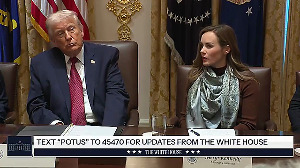'As far as acquisition of Russian equipment is concerned, with about 70% of Indian military equipment being of Russian origin, a sudden decision to abandon imports from Russia is not feasible,' points out Brigadier S K Chatterji (retd).

The run-up to the first 2 Plus 2 dialogue between the Americans and the Indians in New Delhi was preceded by substantial scepticism based on issues concerning India's dealings with the Russians and Iranians.
These included the Indian insistence on buying the S 400 Triumf Russian air defence system, continuing with imports of limited quantities of Iranian crude and construction of the Chabahar port.
The dialogue participants aside, there were two powerful national leaders at opposite ends trying to tailor the trajectory of Indo-American relationship.
Both President Donald J Trump and Prime Minister Narendra Damodardas Modi are known for digging their heels-in.
Modi had remained firm during the 79-day stand-off at Doklam between the Chinese and Indian armies. Trump has launched his relentless trade war against China.
The Delhi meeting with Michael Pompeo and Jim Mattis on one side and Sushma Swaraj and Nirmala Sitharaman on the other, was handicapped, as we thought, with both leaders likely to take unyielding positions.
What happened was an anti-climax perhaps. The meeting proved to be a substantial step forward in Indo-American relations.
The boost that Strobe Talbott and Jaswant Singh had given to Indo-American relationship post the 1998 Indian nuclear tests, now stands cemented on a more equal footing that could cause a lot of concern to the Chinese, Russians, Pakistanis and a few more countries.
The most important agreement signed was the Communication Compatibility and Security Agreement, COMCASA.
In the modern battlefield communications are extremely important for responding in an extremely constricted time span that characterises combat situations.
Equally important is communications not being compromised or interfered with. All this is possible only if the equipment and encryption used are compatible and secure.
Post COMCASA, India and American forces will be able to achieve greater inter-operability.
The signing of the COMCASA agreement has been preceded by a long run of almost 10 years.
COMCASA will allow Indian forces to access encrypted US data links that inter-phase communications of US land, sea, air and subsurface platforms.
Indian forces will be able to hook on to the US Combined Enterprise Regional Information Exchange System or CENTRIXS communications grid.
In the past, such linkages were provided only for the duration of joint or multi-lateral exercises.
The signing of COMCASA has other implications too. It eases the acquiring of drones that India has been keen about. The contract for $2 billion worth of 22 Sea Guardians is important for both countries.
For the Americans it is more than just a business opportunity, while for the Indians it's a huge boost to the Indian Navy's surveillance capabilities in the Indian Ocean region.

The other communication related issue addressed is provisioning of hot lines between the Indian foreign and defence ministers and the US secretaries of state and defence.
Keeping in view the increasing Chinese presence in the Indo-Pacific region, closer liaison between the two navies is of greater import.
An Indian Navy officer will be posted at the US Navy Central Command (NAVCENT)'s Manama-based HQ. A linkage with the US Central Command has its own advantages.
Currently, India is in the jurisdiction of the Hawai-based recently re-named INDO-PACOM while Pakistan is in CENTCOM's precincts. Positioning an Indian officer at the US Central Command would facilitate better understanding of Pakistan centric issues.
A tri-service exercise is also being planned along the Indian east coast. Apparently, the exercise will involve an amphibious landing.
The US will surely field its Marines for the landing phase. They are the best experienced soldiers in amphibious operations. Personnel of the Indian amphibious brigade would be keen to inter-act with them.
Our large number of islands in the Indian Ocean region call for a high state of readiness for undertaking amphibious operations.
Such an eventuality may also be required in support of the littoral States of the Indian Ocean region as was the case in the Maldives after a coup attempt in 1988.
The two sides also discussed the issue of Indian membership of the Nuclear Suppliers Group. Chinese resistance was quoted by both sides as the sole impediment. However, the Americans have committed to progressing the case.
With India having now joined the Wassenaar Arrangement, the Chinese would find it more difficult to attract support for its stance.
US policies in the region have not been fully sensitive to Indian concerns in the past.
The USA-Pakistan relationship is a case in point. The Americans have always pressurised Pakistan to address terrorist groups based along its western borders that cause havoc in Afghanistan. However, the US was not insistent on Pakistan similarly addressing the issue to its east, where terror groups operating from Pakistan administered Kashmir strike across the Line of Control, in India.
Pompeo halted in Pakistan and met Pakistan Prime Minister Imran Khan before landing in New Delhi. There were no promises of the American tap being kept open to finance Pakistan.
Both Pompeo and Mattis have stated that they would find a way to keep India out of the scope of Countering America's Adversaries through Sanctions Act (CAATSA) with the Indian side not ready to give up on either the Russian surface to air S 400 Triumf acquisition or Iranian crude and the Chabahar port.
If the Iranian issue is viewed in a larger framework, the port India is constructing at Chabahar could be utilised for movement of logistics to Afghanistan, via Iran.
It may be a long shot, but with US-Pakistan relations uneasy and the crossings across the Durand Line not assured, Chabahar provides an alternative for the movement of logistics.
If the Iranian nuclear deal was in place, the possibility could have become a reality more easily.
As far as acquisition of Russian equipment is concerned, with about 70% of Indian military equipment being of Russian origin, a sudden decision to abandon imports from Russia is not feasible.
The Americans realising that India needs to maintain relations with Iran and Russia would make it much easier to build the Indo-American relationship. India's national security advisor has already visited the US, post the 2 plus 2 dialogue, to pursue the issue.










